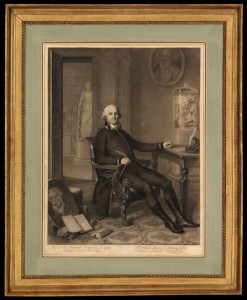 London’s Wellcome Library, one of the world’s foremost collections of medical history, has acquired a portrait of French surgeon Ange-Bernard Imbert Delonnes and the famous 28-pound tumor he removed from the testicles of Charles-François Delacroix, French Minister of Foreign Affairs, in a risky operation on September 13th, 1797.
London’s Wellcome Library, one of the world’s foremost collections of medical history, has acquired a portrait of French surgeon Ange-Bernard Imbert Delonnes and the famous 28-pound tumor he removed from the testicles of Charles-François Delacroix, French Minister of Foreign Affairs, in a risky operation on September 13th, 1797.
The black chalk and white gouache drawing by Pierre Chasselat is dated Year 8 of the French Revolutionary calendar (1799-1800 in our calendar) and it depicts Imbert Delonnes seated in neoclassical dignity penning a manuscript of his book “Progress of the art of healing.” Behind him to the right is the gigantic tumor itself proudly displayed in an oversized bell jar on a marble plinth. In the library behind him there’s a statue of Aesculapius, Greek god of medicine and healing, perched on a plinth that looks identical but smaller, which just goes to show just how proud of that tumor Imbert Delonnes was.
He had good reason to be. Delacroix had eight doctors consulting on what to do about this 30-pound groin situation. Seven of them agreed that it should not be touched, that the tumor could not be removed surgically and that the attempt would pose far greater risk to the patient than just leaving the benign tumor alone to keep on growing. Imbert Delonnes was the only one who disagreed. After Delacroix read his treatise on the treatment of hydrocele (an accumulation of fluid in body cavities or around a testicle), he decided to let Imbert Delonnes remove the tumor surgically.
The operation took two and a half hours and was a success, not just for the patient but for the surgeon and even for surgery itself, still at this point considered a craft of barbers, distinct from and distinctly inferior to pure medicine. The statue of Aesculapius and the rich library he presides over in the drawing represent Imbert Delonnes’ elevated status: surgeon, yes, but in the classically educated tradition, not from the barbershop.
(Related historical fun fact: the tumor rendered Delacroix impotent, so when his wife gave birth to a son eight months after the operation, rumors abounded that little Eugène was actually the son of Charles-François’ successor as foreign minister, Maurice de Talleyrand, to whom he bore a striking resemblance. Eugène Delacroix would grow up to become the great French Romantic painter of Liberty Leading the People fame.)
Delacroix’s tumor was not the only one Imbert Delonnes removed. Another one of his famous surgeries is also referenced in the portrait. In the left foreground there is a painting of Périer de Gurat, mayor of Angoulême, who had a large disfiguring facial tumor. Imbert Delonnes successfully removed that one too and reconstructed his nose afterwards. He commissioned artist Joseph Boze to make a painting of de Gurat’s tumorous face on the night before the operation, and it’s that painting you see in Chasselat’s drawing.
This remarkable drawing is a recent discovery. It was found by Marc Fecker of Didier Aaron Ltd. who then researched assiduously to find out who its noble subject was. He was able to identify the sitter as Ange-Bernard Imbert Delonnes when he found an engraving in the Bibliothèque Nationale de France of just the doctor’s head and shoulders copied from the drawing and labelled as a portrait of Imbert Delonnes.